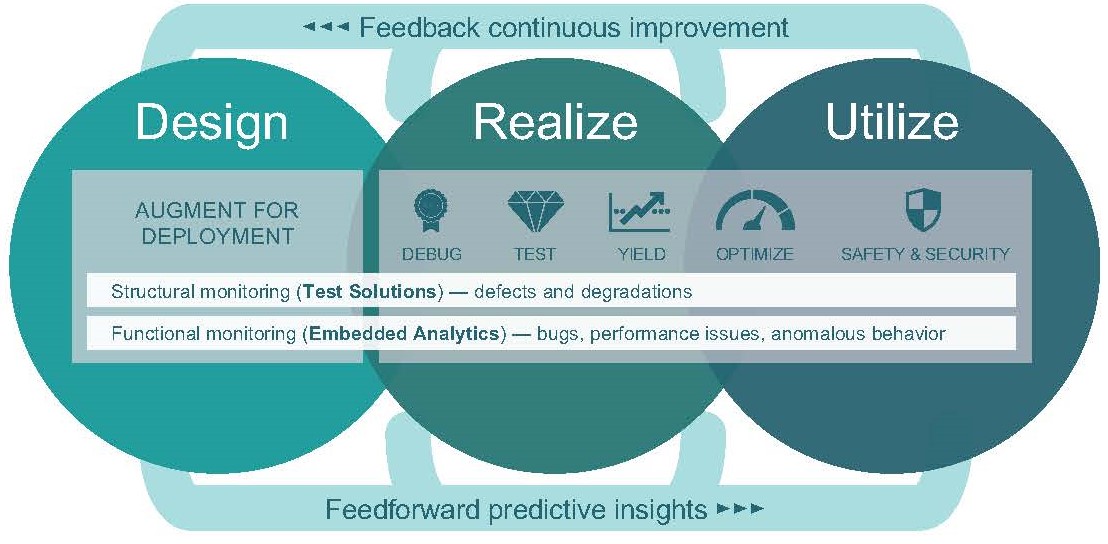Manage the effects of chip complexity with Embedded Analytics

By Richard Oxland – Siemens Digital Industries Software
If you’ve never heard of Embedded Analytics, it’s time to learn how this class of silicon intellectual property (IP), software tools, APIs and libraries can bring a new level of visibility into both the IC development cycle and the IC’s in-life deployment.
Embedded Analytics IP ensures that your chip does what it was designed to do, safely and securely. This includes IP for cybersecurity and functional safety, which is a requirement for many automotive systems. It also helps semiconductor companies solve complex design problems and improve the reliability and performance of their products by leveraging data throughout the product lifecycle.
One of the key motivations for using Embedded Analytics is the explosion of chip complexity that brings new urgency to the question of how to deliver high-quality and competitive chips to market as quickly and efficiently as possible. Today’s problems go beyond making simple tradeoffs between quality, speed and cost. Concerns now also include security, safety, and total cost of ownership. There is a significant monetary cost to the increased systemic complexity, with a large proportion going to chip validation. There is also the cost of reputational damage and financial impact if something goes wrong with the chip in the field. The situation logically calls for semiconductor companies to increase their investment in ways to harness and manage chip complexity.
What does harnessing chip complexity entail? Primarily, we see the greatest value in getting system-level visibility into the functional operation of the chip. This includes three elements that work together:
- A view that encompasses all of the chip’s subsystems and components
- Appropriately detailed information about any subsystem or component whenever detail is needed
- A coherent and accurate picture of chip operation at any given time
An inherent aspect of achieving system-level visibility is data. There will be an avalanche of data, so the development teams need to know when and what data to collect, to filter the data, and to interact with it. Applications and APIs enable you to manipulate the data.

What can you do with an Embedded Analytics platform?
You can find relevant patterns and valuable insights in a broad range of situations. SoC verification teams can feed insights back to the SoC design team. You can detect and block on-chip transactions that fall outside of parameters. Combine on-chip and off-chip analytics as needed. The result is a single data analytics platform that covers SoC development and embedded system operations. This investment offers a clear return: the value of system-level data for improving not just the design process but keeping the chip safe and secure in the field through over-the-air updates stands as a clear competitive advantage.
The Tessent™ Embedded Analytics platform integrates smart on-chip monitoring, communications hardware and software, APIs and application software. It is a scalable, flexible and powerful solution for harnessing complexity in SoCs and embedded systems. With the flexibility of a platform implementation, Tessent Embedded Analytics can be a single source of data, form the basis for collection of an even richer data set using other sources, or it can augment existing platforms as another source of insights. As part of the Siemens Xcelerator portfolio, the right SoC and embedded system data can add enormous value to a digital twin strategy. Potential application spaces include advanced predictive yield of embedded systems, through to digital representations of infrastructure and whole systems of systems such as manufacturing facilities, datacenters and IoT fleets.
Embedded Analytics is part of the Tessent Silicon Lifecycle Solutions (SLS) offering, which applies product lifecycle management principles to the semiconductor industry. SLS leverages data to allow IC makers to manage the performance of their products from inception through design, manufacture, and deployment.
Embedded Analytics also brings a new set of functionality to the simulation, emulation and prototyping phases of SoC development. This means that teams using Siemens EDA products such as the Questa Advanced Simulator, Veloce® Strato™ Emulation Platform and the Veloce® Prototyping System can also benefit from system-level visibility. This approach enables a unified view of the SoC across the whole development cycle, allowing teams to correlate results from phase to phase and set up efficient feedback loops for optimizing the product, both for this product generation and for the generations that will follow.
To learn more, including a description of all the components of the Tessent Embedded Analytics platform, download the white paper here:
https://resources.sw.siemens.com/en-US/white-paper-embedded-analytics-a-platform-approach


